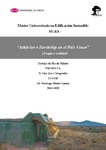Mostrar el registro sencillo del ítem
Arkit-lur o Earthship en el País Vasco: ¿Utopía o realidad?
| dc.contributor.advisor | Muñiz Gómez, Santiago | |
| dc.contributor.author | Juez Uriagereka, Oier | |
| dc.contributor.other | Universidade da Coruña. Escola Universitaria de Arquitectura Técnica | es_ES |
| dc.date.accessioned | 2023-02-14T16:49:53Z | |
| dc.date.available | 2023-02-14T16:49:53Z | |
| dc.date.issued | 2020 | |
| dc.identifier.uri | http://hdl.handle.net/2183/32472 | |
| dc.description.abstract | [Resumen]: La edificación sostenible es una forma más responsable de garantizar que la construcción se mantenga al día satisfaciendo la demanda del mercado sin el profundo impacto ambiental que se está dando hasta el momento. Hay otras formas de realizar los proyectos. La construcción sostenible se enfoca en satisfacer las necesidades de los seres humanos sin comprometer a las generaciones futuras. Pero ¿se adaptan estos diseños a todo tipo de climatologías? El enfoque del trabajo se centra por tanto en estudiar y analizar las edificaciones de tipo nave tierra o Earthship en el entorno del País Vasco sometido a unas condiciones atmosféricas específicas. Así, se analizan los pros y contras de este tipo de construcciones. Mediante este trabajo, se pretende poner en valor las diferentes oportunidades que se ofrecen desde el mundo de la arquitectura y la construcción sostenible. La escala aplicada al estudio abarcará desde una perspectiva de detalle, estudiando la composición y características constructivas de los elementos existentes en un núcleo, pasando por el conjunto de la edificación y de sus características de implantación bioclimática, hasta un análisis a escala territorial a nivel de núcleo que valore la potencialidad del entorno, con un claro y firme acento en la consecución de un alto nivel de confort, de nivel de vida, para sus habitantes y usuarios. Cabe destacar que a pesar de que la viabilidad de las naves tierra en el País Vasco pueda llegar a ser posible, su elevado coste es comparable al de una vivienda unifamiliar tradicional siendo este tipo de viviendas no tan ecológicas como a priori dicen ser. | es_ES |
| dc.description.abstract | [Abstract]: The impact of currently established building methods has a substantial negative effect on the environment. In detail, the negative issue can be seen throughout the building live-cycle reaching from material sourcing, over energy efficiency with respect to climatisation during use to deconstruction and the final storage of environmental unfriendly materials. To cope with this issue a multitude of sustainable building methods have been shown to be successful. Sustainable building is a more responsible way of ensuring that construction keeps up to date by meeting market demand without the profound environmental impact that is occurring so far. Sustainable construction focuses on meeting the needs of human beings without compromising future generations. One promising sustainable building approach is the so called Earthship. Earthships stand for a brand of passive solar earth shelter that is made of both natural and upcycled materials such as earth-packed tires, pioneered by architect Michael Reynolds. Until now the feasibility has been shown in (sub-tropical/Continental climate). But are these designs adapted to all types of climate? Hence there is further work required on determining the general feasibility of this concept. As such, this work focuses providing an exemplary case study by analysing the applicability and therewith related pros and cons of the Earthship-type buildings in Basque Country. The scale applied to the study will cover from a detailed perspective, studying the composition and constructive characteristics of the existing elements in a nucleus, going through the whole of the building and its bioclimatic implantation characteristics, to an analysis at a territorial scale at the level of nucleus that values the potential of the environment, with a clear and firm emphasis on achieving a high level of comfort and standard of living for its inhabitants and users. The study concludes that the feasibility of the Earthships in Basque Country is possible even if they are not as sustainable as they seem. Moreover, the real cost of such buildings might be more expensive compared to a traditional stand-alone or single detached dwelling house. | es_ES |
| dc.language.iso | spa | es_ES |
| dc.rights | Os titulares dos dereitos de propiedade intelectual autorizan a visualización do contido deste traballo a través de Internet, así como a súa reproducción, gravación en soporte informático ou impresión para o seu uso privado e/ou con fins de estudo e de investigación. En nengún caso se permite o uso lucrativo deste documento. Estos dereitos afectan tanto ó resumo do traballo como o seu contido Los titulares de los derechos de propiedad intelectual autorizan la visualización del contenido de este trabajo a través de Internet, así como su repoducción, grabación en soporte informático o impresión para su uso privado o con fines de investigación. En ningún caso se permite el uso lucrativo de este documento. Estos derechos afectan tanto al resumen del trabajo como a su contenido | es_ES |
| dc.subject | Nave tierra | es_ES |
| dc.subject | País Vasco | es_ES |
| dc.subject | Edificación sostenible | es_ES |
| dc.subject | Earthship | es_ES |
| dc.subject | Basque Country | es_ES |
| dc.subject | Sustainable building | es_ES |
| dc.title | Arkit-lur o Earthship en el País Vasco: ¿Utopía o realidad? | es_ES |
| dc.type | master thesis | |
| dc.rights.accessRights | open access | es_ES |
| dc.description.traballos | Traballo fin de mestrado (UDC.EUAT). Edificación sostenible. Curso 2019/2020 | es_ES |
| UDC.coleccion | Traballos académicos | es_ES |
| UDC.tipotrab | TFM | es_ES |
| UDC.titulacion | Máster Universitario en Edificación Sostible | es_ES |






